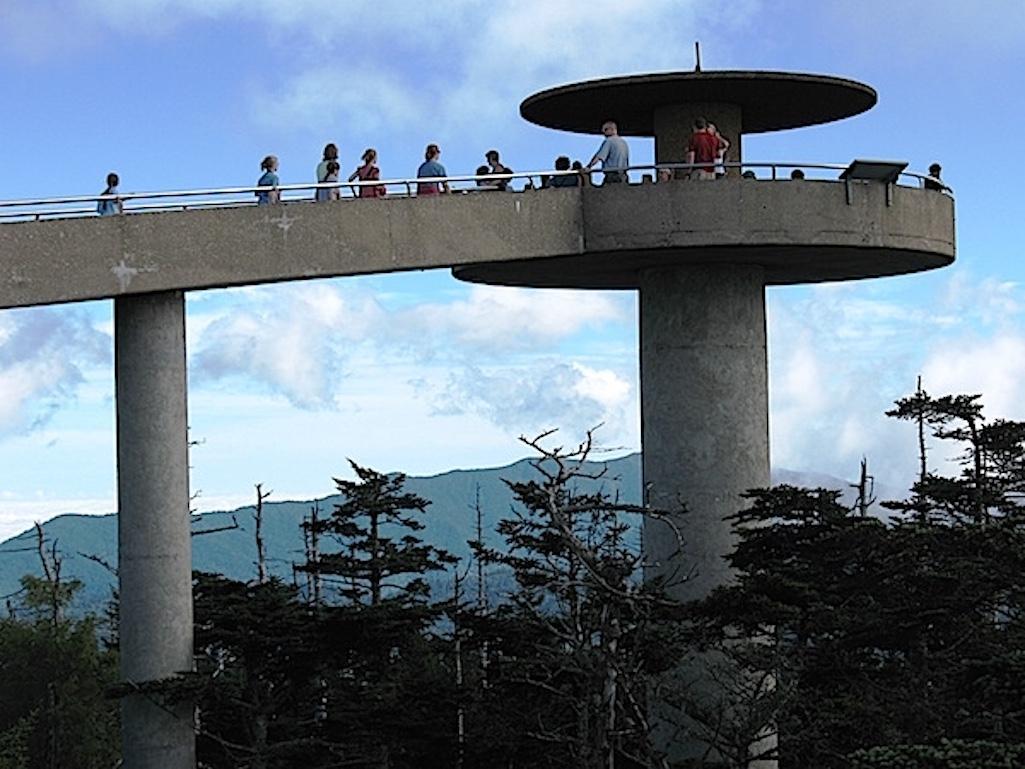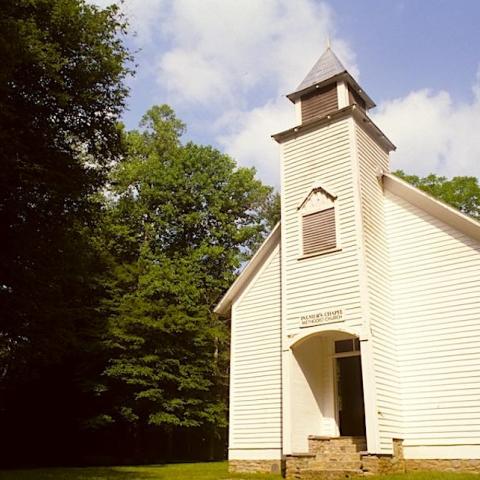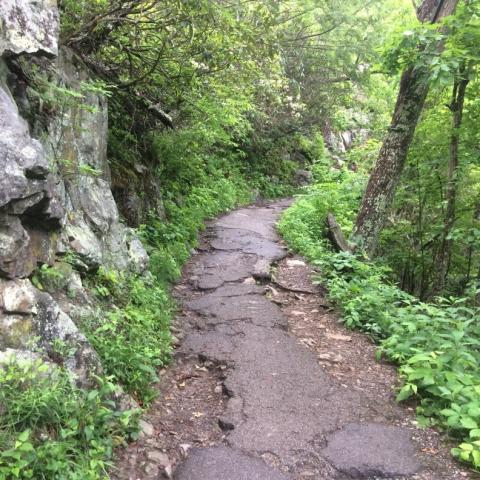
Clingmans Dome at Great Smoky Mountains National Park has been renamed for a Cherokee word meaning "mulberry place."/NPS file
The U.S. Board of Geographic Names on Wednesday voted to change the name of the highest point in Great Smoky Mountains National Park from Clingmans Dome to Kuwohi, a Cherokee name for the mountain.
The Eastern Band of Cherokee Indians (EBCI) earlier this year petitioned the board to make the name change. Kuwohi translates to “mulberry place.” In Cherokee syllabary, the name is ᎫᏬᎯ, according to a release from the national park.
The National Park Service strongly supported the name restoration and applauded the decision, which also received support from local communities and governments. County commissions in both Tennessee and North Carolina reportedly have voted in favor of the name change.
Kuwohi is a sacred place for the Cherokee people and is the highest point within the traditional Cherokee homeland. Kuwohi is visible from the Qualla Boundary, the home of the Eastern Band of Cherokee Indians. Efforts are already underway to update signage, website and other materials with the Kuwohi name.
“The Great Smoky National Park team was proud to support this effort to officially restore the mountain and to recognize its importance to the Cherokee People,” said Superintendent Cassius Cash. “The Cherokee People have had strong connections to Kuwohi and the surrounding area, long before the land became a national park. The National Park Service looks forward to continuing to work with the Cherokee People to share their story and preserve this landscape together.”
The proposal was submitted in January of this year by EBCI Principal Chief Michell Hicks following an effort started in 2022 by Lavita Hill and Mary Crowe, both enrolled EBCI members, to restore the traditional name of the summit.
Kuwohi is one of the most popular sites in Great Smoky Mountains National Park with more than 650,000 visitors per year. It is the tallest point in Tennessee and the third-highest summit east of the Mississippi River.
The park closes Kuwohi for three half-days annually to provide access to predominantly Cherokee schools to visit the mountain and learn the history of Kuwohi and the Cherokee people from elders, Cherokee language speakers, culture bearers and community members.
The mountain became known as Clingmans Dome following an 1859 survey by geographer Arnold Guyot, named for Thomas Lanier Clingman who was a lawyer, U.S. Representative and Senator from North Carolina, and Confederate Brigadier General.
The name change is just latest in the National Park System.
Back in 2022 the National Park Service announced that Mount Doane in Yellowstone National Park had been renamed First Peoples Mountain.
First Peoples Mountain is a 10,551-foot peak within Yellowstone east of Yellowstone Lake in the southeastern portion of the park. The peak was previously named after Gustavus Doane, a key member of the Washburn-Langford-Doane expedition in 1870 prior to Yellowstone becoming America’s first national park. Research has shown that earlier that same year (1870), Doane was involved in an attack, in response to the alleged murder of a white fur trader, on a band of Piegan Blackfeet. During what is now known as the Marias Massacre, at least 173 Native Americans were killed, including many women, elderly tribal members and children suffering from smallpox.
Then-Interior Secretary Sally Jewell in August 2015 directed that Mount McKinley in Denali National Park be officially renamed "Denali," the traditional Koyukon Athabascan name of the peak. Secretary Jewell gained the support of President Obama to issue a Secretarial Order that officially changed the name.
Since 1987 and until August 2015 the official name of the mountain in federal publications had been Mount McKinley. The mountain retained the federally authorized name Mount McKinley, even as the name of the national park was changed in 1980 from Mount McKinley National Park into the new (and larger) area named Denali National Park and Preserve under the Alaska National Interest Lands Conservation Act.
The mountain's McKinley name dates to 1896, when a prospector emerged from exploring the mountains of central Alaska and received news that William McKinley had been nominated as a candidate for president of the United States. In a show of support, the prospector declared the tallest peak of the Alaska Range as Mount McKinley — and the name stuck. For centuries, the mountain that rises more than 20,000 feet above sea level, the tallest on the North American continent, had been known by as Denali.




 Support Essential Coverage of Essential Places
Support Essential Coverage of Essential Places







Comments
Largely forgotten is Clingman's long career as a member of Congress from North Carolina, where he was an outspoken Senate proponent of the "inequality of the negro," and championed the legitimacy of slavery and secession. Even though Clingman took up arms against the United States he was slow to resign his senate seat. Consequently, he has the dubious distinction of being formally expelled by a vote of his senatorial colleagues for conspiring "against the peace, union, and liberties of the people and Government of the United States." Reason enough for a name change for such a high profile NPS destination.
Rolf Diamant
Gee, why not just call it "Mulberry Dome"?
After all, we're using the ENGLISH LANGUAGE to descibe a place in writing that never had a written name--when settled, the Cherokee, like ALL indigionus groups in N. America, never has written language.
Reason enough for a name change for such a high profile NPS destination.
Not really.
There were plenty of folks who took up arms against the US to fight for slavery, including most of the 5 so-called "Civilized Tribes". Based on your "logic", we should wipe much of the Indian place-names from the map of Oklahoma for their support of slavery. Right?
Close to the point is the historical FACT that the Eastern Cherokees, who are now advocating for this name change, ALSO fought for slavery (and the Confederacy) during the Civil War! Another historical note must be made that Confederate General Stand Watie-- a Cherokee!--was the last Confederate General to surrender.
Now, a reader might wonder why so many NAs (not all of course) fought for and supported the Confederacy. Well, they too wanted to maintain their slave-owning lifestyles and tried to do so well beyond the end of the Civil War.
So, we're changing the place-name of Clingmans Dome from one Confederate based on the desires of other historical Confederates. You call that progress?
ENOUGH of this US .v THEM.
When we try to whitewash away the naming of Clingman's Dome, we lose much of the historical context described above. And I for one say, NO, HE!! NO!
Just simply enough already.
This is expressed in Cherokee as "Kuwohi" to reflect the written language that the Cherokee people were using at the time, including the Cherokee Phoenix newspaper that began publication in 1828. This name moves the issue away from a "person-name" - and yes, many of the persons involved were slave-holders, both Cherokee and North Carolinian - to a "concept-name (mulberry)" with roots in the local Cherokee culture, including the written Cherokee language.
A "citizen" of the Cherokee nation?
Wasn't the main point of the Civil War to decide that folks could not unilaterally secede from the US and create their own nations?
It is truly ironic that Thomas Clingman himself would have supported the E. Cherokee's "right" to secede and create their own "nation"!
Come on, man!
Oh please! So since, by this logic, if a U.S. President has some "fault" by our "modern" standards, ie was a slave owner, shall we delete that person from the list of past Presidents? When will this effort to "right the wrongs in our history" ever end?
Almost all ancient nations and ethnic groups practiced slavery and we're subject to enslavemen. African slavery began in Africa, with Africans enslaving other Africans for the benefit of Africans. It was common practice when African tribes warred, for victorious tribes to enslave the defeated tribe members, especially women and children. Usually, the men and boys of fighting age were killed, while the women and children were made slaves. Usually, their slave systems were more brutal than that which was practiced in the U. S.
All or almost all of that Native American tribes practiced slavery in much the same way as African tribes. But rarely did American tribes sell their slaves to whites, as the Africans did.
The Right of a State to secede was established when R.I., N.Y. and Va. were admitted with the expressed caveat that they could withdraw of their own volition and discretion. By the equal standing rule, multiple times affirmed by the Supreme Court, the caveat Right was made applicable to ALL the States.
The Southern States that formed the Confederacy believed they had that Right as also expressed in the Declaration of Independence. They "bore arms" against the U.S. as an independent nation, who was first blockaded and then invaded - both acts of war, which legally warrant an armed response.
When the War started there were more "slave states" in the Union than in the Confederacy. During the war and after the Emancipstion Proclamstion, West Virginia was admitted to the Union as a "slave state".
According to none other than Frederick Douglass, during the War, the largest slave markets were not in the South, but were in NYC and Boston!
The last state to end slavery was the Union State of Delaware, which did so after the War but only because the newly ratified 13th Amendment required it.
Lincoln himself said the War, which he launched, was not to end slavery. The "War Aims Resolution" passed by the U.S. Congress did not mention ending slavery.
No, the War was over Southern independenc, which if effected would have devastated the economy of the Northern States. This was widely understood at the time.